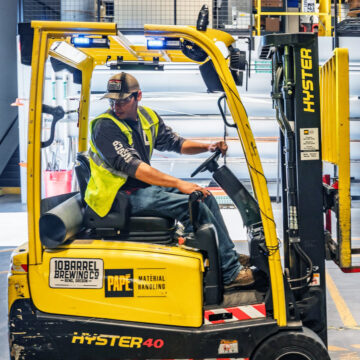Warehouse workers are often required to perform various tasks that put their physical safety in question. Some of these activities include loading trucks, assembling items, controlling inventory, labelling items, arranging transportation, packaging orders, breaking bulk materials, and much more. Keeping these employees safe is a key responsibility for those in charge of warehousing facilities.
The first step towards preventing warehouse accidents is to be aware of the most common injuries and the factors responsible for them.
- A high percentage of warehouse accidents result from the use of heavy pallets, forklifts, and other heavy equipment. People working in warehouses regularly face the risk of falling from an elevated platform, falling between the trailer and the lift, and being hit or run over by forklifts.
- Slips, trips, and falls also contribute significantly to injuries in the warehouse. These incidents are the results of uneven or slippery floors, and accumulation of grease, residue, debris, etc.
- Hazardous chemicals are stored and used by many warehouses for production purpose. Spillage and leakage of these chemicals can be serious threats to employee safety.
- Another massive risk for warehouse workers is being hit by stacked objects falling from shelves. In most instances, these injuries are caused by human error and incompetent operational setup.
- Machine entanglement is another serious security threat for warehouse employees. These injuries occur when workers get entangled with large and potentially dangerous equipment.
Some Common Tips for Warehouse Safety
- Implementation of adequate safety measures such as forklifts or hydraulic lifts.
- Following proper housekeeping practices to eliminate the probability of slip and trip hazards.
- Many serious workplace injuries can be prevented by using signs and stickers to label materials, equipment, and racks. All emergency exits and their routes should also be clearly marked.
- All employees should be made aware of the consequences of an unsafe workplace and trained adequately about warehouse safety processes.
- Use of protective clothing such as gloves, hard hats, eye-wear, masks, and hats can help avoid many serious injuries. Also, warehouse workers should always avoid wearing loose-fitting clothes.
- Safe shelving practices can prevent workers from injuries caused by falling objects.
- Regular fire safety drills can help create and update a safe evacuation and emergency plan.
Technology Tools for Warehouse Safety
In addition to the basic safety measures discussed above, there are a number of advanced technology tools that can make warehouse environments safer for the workers.
- Pedestrian Alert Systems: These are essentially forklift proximity warning systems capable of preventing workplace accidents taking place between pedestrians and forklift trucks.
- Collision Avoidance Systems: These systems help avoid collisions by cautioning forklift drivers when other vehicles are nearby.
- Blind Spot Systems: When used in poor visibility areas, these systems can significantly minimise collision risk.
- Visual Alert Systems: Alerts forklift operators and pedestrians in risky situations.
- Ultrasonic Proximity Alert Systems: helps minimise accidents between pedestrians, obstacles, and vehicles.
- Narrow Aisle Safety Systems: Can be used in narrow work spaces to prevent collision between forklifts.
- Truck Docking Systems: Protects loading dock personnel from potential injury risks.
Over the last 40 years, we have been delivering state-of-the-art damage prevention solutions to many multi-national companies and small businesses. Please contact us today to create your warehouse safety plan.


